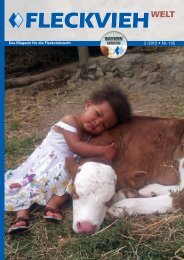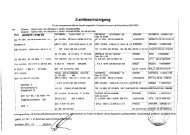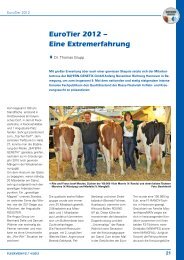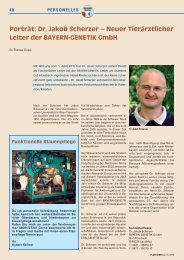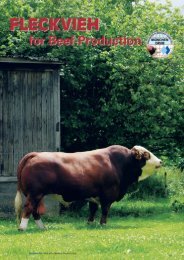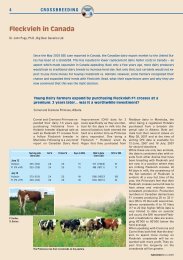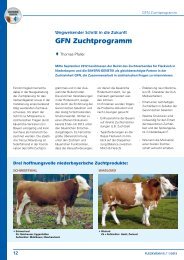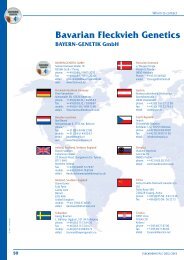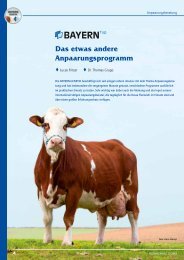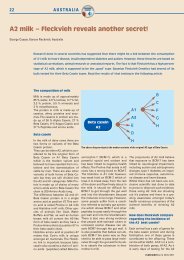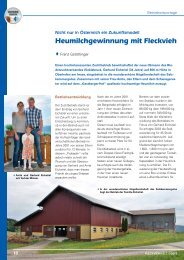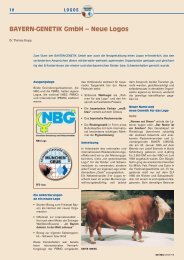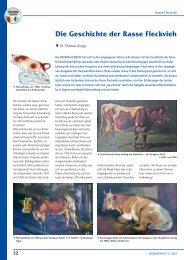RIEDBOW DAIRY - Crossing Holsteins with Bavarian Fleckvieh A ...
RIEDBOW DAIRY - Crossing Holsteins with Bavarian Fleckvieh A ...
RIEDBOW DAIRY - Crossing Holsteins with Bavarian Fleckvieh A ...
Create successful ePaper yourself
Turn your PDF publications into a flip-book with our unique Google optimized e-Paper software.
4 Crossbreeding<br />
<strong>RIEDBOW</strong> <strong>DAIRY</strong> -<br />
<strong>Crossing</strong> <strong>Holsteins</strong> <strong>with</strong> <strong>Bavarian</strong> <strong>Fleckvieh</strong><br />
A vision for success in the Canadian Dairy Business<br />
Dr. John Popp<br />
Big Bear Genetics Ltd.<br />
Al and Hilly Riedstra and their children<br />
Tetsje, Jennie, Al, Henry, Alieda, Derrick<br />
and Judith are Riedbow Dairy. The family,<br />
originally from Holland, moved to Elm<br />
Creek, Manitoba in Canada in 1987 <strong>with</strong><br />
a vision and dream to build a dairy. Starting<br />
out <strong>with</strong> 30 cows <strong>with</strong> 370 liters of total<br />
production the family developed an impressive<br />
dairy operation. They are currently<br />
milking 310 commercial Holstein<br />
cows in a free stall system <strong>with</strong> plans to<br />
go to 400 by next year. When you meet<br />
the family you will see what determination<br />
is – intricate and well thought out ties of<br />
management of people, animals and feeding.<br />
Everyone doing their job and doing<br />
it well.<br />
The herd production average is 10’500 liters,<br />
3.75% fat and 3.43% protein. Somatic<br />
cell count at 180’000. The cows<br />
are fed a TMR consisting of 60% forage<br />
and 40% concentrate on a dry matter basis.<br />
Of the 60% forage, corn and alfalfa<br />
silage represent 45% each <strong>with</strong> the remainder<br />
being oat greenfeed – dry and<br />
long fiber to add to rumen health. Hammered<br />
corn grain is the concentrate source<br />
<strong>with</strong> added supplement and soybean<br />
meal to have the protein at 18%.<br />
The cows weigh 1350 to 1500 lbs and are<br />
eating 52 lbs of dry feed. ‘Using higher<br />
levels of fiber (up from 50% to 60%),<br />
keeps cows healthier and we have not<br />
Feed mill <strong>with</strong> hutches in foreground.<br />
Al Riedstra, milking help Henry and Tetsje.<br />
lost production’ says Al Riedstra. ‘Transition<br />
on freshening cows now is virtually<br />
trouble free’, comments Al – ‘a lower percentage<br />
of distended abomasums’. Knowing<br />
the value of feed and how to manage<br />
cows is the strength of the dairy. They<br />
put up the feed, but have neighbors growing<br />
a lot of it for them. Only the dry cows<br />
go to pasture to graze; Al comments that<br />
the nutritional value of grass is only right<br />
for milking cows for 3 to 4 weeks, so why<br />
come out of the barn.<br />
Everyone has their tools of the trade for<br />
rearing replacement calves. The Riedstra<br />
family built a calf rearing barn, but are<br />
now changing it for feeding space for older<br />
heifers. ‘The ammonia levels in the<br />
barn were too high and it was not good<br />
Left – Manager cross; Right – Samurai cross. Good feet and legs and added<br />
strength.
for calf health’ comments Al. Calves are<br />
in hutches by themselves for the first 2<br />
months and then move to larger hutch<br />
areas and are kept in groups of 3 to 4.<br />
Once at 4 to 5 months they move on to<br />
larger animal groups in pens again. ‘It’s<br />
still the best way to keep them healthy!’.<br />
The cows are milked twice daily in a 20<br />
cow parallel parlor. Al gets up at three to<br />
start the morning milking. ‘It gives me a<br />
chance to see the animals and know how<br />
things are working’ Al says. Milking takes<br />
4 hours and is done twice a day. One of<br />
the top cows in the dairy is sired by Rudolph.<br />
On her first lactation of 287 days<br />
she milked 11676 kg, peaking at 44 kg.<br />
Her 2nd lactation was 14361 kg on 305<br />
days <strong>with</strong> a peak of 54 kg. At the time of<br />
the picture she is nearing the completion<br />
of her 3rd lactation, at 204 days pregnant,<br />
still milking at 40kg and a 305 day production<br />
of 16480kg. She is in calf to a top<br />
<strong>Fleckvieh</strong> bull, Manager. Another Rudolph<br />
daughter, #301, pictured was dry<br />
for only 4 days between her 3rd and 4th<br />
lactation. At the time of the picture she<br />
was 231 days pregnant, <strong>with</strong> a production<br />
of 12590 kg. She is in calf to another top<br />
<strong>Fleckvieh</strong> sire, Randy.<br />
Another interesting part of the operation<br />
is in the bedding area of the free stall<br />
barn. The cow beds are foam <strong>with</strong> rubber<br />
overlays. Finely chopped straw is placed<br />
on the bed surfaces and the edges are<br />
swept <strong>with</strong> a rotary brush and limed twice<br />
daily. Chopping the straw very fine (1 to<br />
2cm length) reduces the amount of bedding<br />
required and keeps things dry and<br />
clean. Lime application and bedding method<br />
both help to preserve udder health<br />
and reduce problems <strong>with</strong> mastitis and<br />
cell count.<br />
After seeing an impressive Holstein dairy<br />
operation like this, one might ask – why<br />
switch to crossbreeding <strong>with</strong> <strong>Bavarian</strong><br />
<strong>Fleckvieh</strong>? Al read an article written ab-<br />
Hutch area: Left – Manager cross; right – Haxzeus cross<br />
out a fellow dairyman, Albert Nyhof, about<br />
an hours’ drive from his place. Albert<br />
Nyhof described the concept of breeding<br />
<strong>Fleckvieh</strong> to his purebred <strong>Holsteins</strong> <strong>with</strong><br />
enthusiasm and excitement. This was<br />
enough to convince Al and Hilly to book a<br />
plane and see <strong>Fleckvieh</strong> perform in Germany<br />
and Holland. When asking Al now<br />
why he switched to have his entire herd in<br />
calf to <strong>Fleckvieh</strong> he will give you simple<br />
reasons: ‘Health, Fertility and Longevity<br />
– I saw dairies that do as well as we do<br />
<strong>with</strong> <strong>Holsteins</strong> for production but their cows<br />
last four lactations instead of two and<br />
a half!’ says Al ‘I can capture the higher<br />
production from the 3rd, 4th and subsequent<br />
lactations! Flat lactation curves<br />
and persistent milk production are also<br />
both a plus for easier feeding management.<br />
I like <strong>Fleckvieh</strong> cows – they are<br />
strong and have good feet and legs!’. At<br />
Crossbreeding 5<br />
this time, the oldest crossbred heifers are<br />
7 months. Son Al notes they grow a lot<br />
better and are generally a lot healthier.<br />
The first Holstein heifers they bred to calve<br />
to <strong>Fleckvieh</strong> were 25 months old, because<br />
they had concerns about calving<br />
ease. They have since gone back to calving<br />
at 22 to 23 months as they found this<br />
not be an issue. When bred to Enrico,<br />
they calve easily and son Al notes he<br />
really likes Enrico cross calves for type.<br />
Cows tend to carry 10 to 14 days longer<br />
than when inseminated <strong>with</strong> Holstein. Al<br />
notes this to be a good thing, because he<br />
can keep cows milking longer.<br />
This article was compiled and written by<br />
Dr. John Popp, Big Bear Genetics Ltd.,<br />
the North American Distribution, Breed<br />
and Information Center for <strong>Bavarian</strong><br />
<strong>Fleckvieh</strong> Genetics based in Erickson,<br />
Manitoba, Canada.<br />
Cow 301 – 4th lacation 12590 kg bred to <strong>Fleckvieh</strong> sire, Randy. Cow 400 – 3 lactation total 42517 kg bred to <strong>Fleckvieh</strong> sire, Manager.



